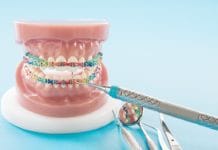“Why do I need to fill out another medical form when everything is still the same?” This is a common question dental practices deal with on a regular basis with many patients. While it may seem like an inconvenience to update a medical history, it is imperative to make sure each patient has given you all of their past and current medical information. A medical history acts as a “blueprint” in determining the safest, optimal care that each patient needs and deserves5. It can also reduce the risk of injury, medical emergency, and lessens the chance of alleged liability towards the clinician1.
More than two hundred million Americans seek some sort of dental treatment each year, whether they come in for regular check-ups or dental emergencies when they are from suffering pain2.
It is more simplified when a clinician is familiar with a patient, one who keeps regular appointments. You know that patient, but it is more complex when a patient comes in for the first time. Either way, medical status can change in just one day, so it is our responsibility to use good judgment and make sure we become familiar with any medical concerns or changes, document them, and provide an acknowledged signature5.
What Should A Medical History Form Consist Of?
Many medical history forms consist of a “yes” or “no” questionnaire. Most forms ask if a patient has ever suffered from any certain systemic illnesses, infectious diseases, organ dysfunctions, blood disorders, prosthetic joints, are undergoing active chemotherapy, has had certain surgical procedures, and if they have any known drug allergies, including anesthetics and latex2. Medical forms should also ask for emergency contact information along with a patient’s physician’s information. Health history forms should contain these critical items4:
- Current and past medical conditions, surgeries, hospitalizations.
- Current prescribed medications, over the counter medications, and herbal supplements
- Current known drug allergies including anesthesia and allergy to latex
- Patient’s blood pressure and pulse
- Emergency contact information
- Physician’s contact information
- Pregnancy status
All this information helps to ensure that you, as a clinician, can treat a patient based on their specific needs while reducing the risk of injury. It also helps if a patient needs a referral, dental or otherwise. Updated and thorough health histories also reduce the risk of negligence. Failure to take the extra time to inquire about a patient’s health can lead to more damage than good.
As an example, let’s say an emergency patient comes in with chronic tooth pain. She stresses she wants her tooth extracted, in which the dentist agrees. This patient is elderly and is currently undergoing chemotherapy for breast cancer. She lists all of her prescribed medications but forgets to mention she is receiving monthly chemotherapy injections of Prolia. The patient is not aware of the risks of injury to her jaw (osteonecrosis). Without inquiring about any “recent hospital visits or recent diagnoses,” the dentist may be risking their license for failing to document and failure to refer the patient to an oral surgeon3. This is just one reason why dental staff should make sure to obtain the most thorough, accurate information at each patient visit. Failing to update medical history is one of the top reasons dentists are sued6.
When Should Medical Histories Be Updated?
There is no exact time required by law to update a patients medical history2,3. Instead, it is recommended to use good judgment with each patient case. At each patient visit, it is highly recommended to update and document any changes. The American Academy of Pediatrics Dentistry Council stated, “A patients’ record is an essential component of the delivery of competent and quality oral health1.”
Who Should Complete The Medical Form or Update?
It is the patient’s responsibility to fill out any medical health history forms unless they are children. If they are under the age of eighteen, a parent or legal guardian should fill out the form and sign it. If a patient is vision impaired, a dental clinician or front desk personnel can assist with helping. If a patient is computer literate, many dental offices websites have downloadable forms which can be filled out before a dental appointment. Once these forms are filled out, it is the clinician’s responsibility to review the medical forms with the patient to make sure the forms are thorough and accurate. It may take a little more time to do so, but the importance of making sure we protect our patient’s overall health is most important.
As a full-time practicing dental hygienist for over twelve years, I believe making sure my patient’s medical history forms are as accurate as possible allows me to take care of my patient’s overall health, not just their teeth. My patient’s smiles are important to me, but their overall health and longevity of life are even more important to me. Being a great dental hygienist means taking the time to make sure you know everything about your patient from head to toe. Knowing this gives you the benefit of providing the most optimal care to your patient.
SEE ALSO: The Importance of Knowing a Patient’s Health History & How to Simplify the Process
DON’T MISS: The Medical History Mystery: Getting Patients to Understand the Importance of Medical Health History
Now Listen to the Today’s RDH Dental Hygiene Podcast Below:
References
- American Academy of Pediatric Dentistry O. Council (2007-2012).
- Board,J. Clinical Practice Statement: Medical History (1-2-2016). Retrieved from http://www.aaom.com/index.php?option=com_content&view=article&id=108:medical-history&catid=24:clinical-practice-statement
- Daly, Christopher. Dental Note: Osteoporosis treatment and medication-related osteonecrosis of the jaws. Retrieved from https://www.ncbi.nlm.nih.gov
- American Dental Association: Dental Records. Retrieved from https://www.ada.org/~/media/ADA/Public%20Programs/Files/MPRG_Dental_Records.pdf?la=en
- Tekavac, Carol. Medical History: An Office’s Responsibility. (Feb. 25, 2008). Retrieved from https://www.dentistry.com
- What are the Most Common Reasons Doctors are Sued for Malpractices? Retrieved from https://www.malpracticecenter.com
















